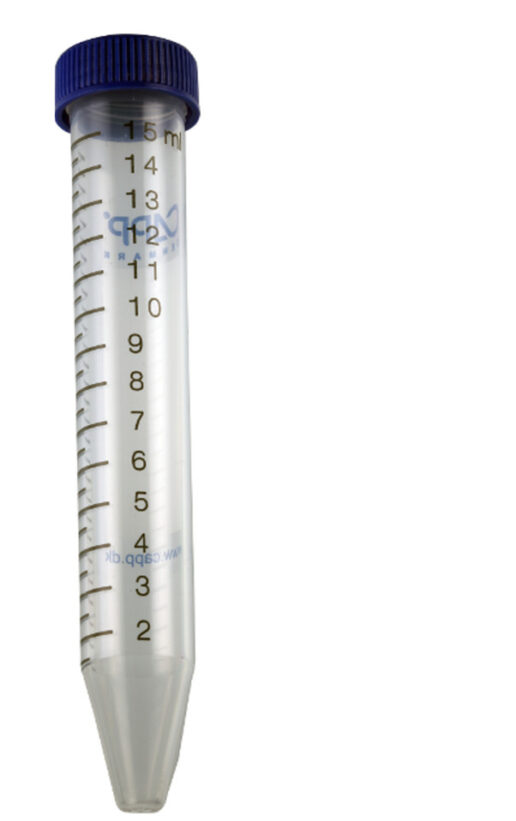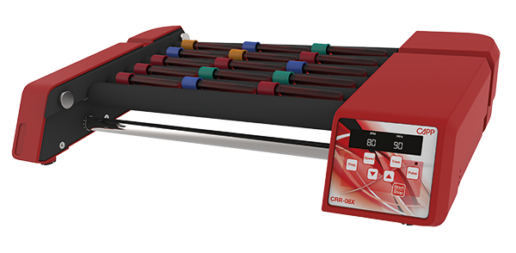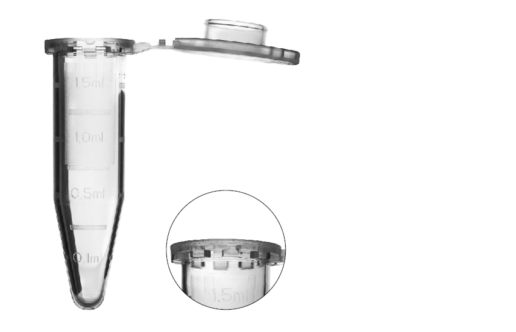
Blood separation
Whole blood is a tissue with several cellular and non-cellular components. The major components of blood are cells, plasma, and platelets (cellular fragments involved in clotting). Blood consists of two types of cells i.e., red blood cells (erythrocytes), and white blood cells (leukocytes). Erythrocytes are the blood cells that distribute oxygen from the lungs to all parts of the living organism. Leukocytes, as part of the immune system, are responsible for attacking any infectious cells, thereby keeping the organism healthy. Leukocytes can be furthermore categorized into lymphocytes, monocytes, eosinophils, basophils, and neutrophils (granulocytes). The components of whole blood can be separated using blood separation techniques such as centrifugation. Blood separation allows scientists to provide treatments and study disease markers using the different components of blood.
Blood cells are suspended in a yellowish substance called plasma. Plasma consists of water and several dissolved molecules. Together, the components of blood plasma account for its large volume in the blood (±55%). Some of the components of blood plasma include glucose, proteins, salts, clotting factors, hormones, immunoglobulins, and carbon dioxide from metabolic processes. Scientists can separate the components of blood plasma and use them to treat medical conditions including injury and disease. As plasma consists of many useful components, good blood separation techniques help clinicians treat patients more effectively.
Separation of blood into its components
 Diagnostic laboratories routinely conduct blood separation assays to test for the presence of disease markers or to prepare for transfusions. Each blood component has its unique function and separating it from the other components may be necessary for accurate diagnoses or effective therapeutic applications. Scientists often use the unique densities of blood components to develop blood separation techniques. These blood separation techniques allow diagnostic laboratories to assay each blood component with great accuracy, and this translates to better outcomes for patients. Although the separation of blood into its components is not an end in itself, it is a critical first step that serves as the foundation for many important diagnostic and research procedures.
Diagnostic laboratories routinely conduct blood separation assays to test for the presence of disease markers or to prepare for transfusions. Each blood component has its unique function and separating it from the other components may be necessary for accurate diagnoses or effective therapeutic applications. Scientists often use the unique densities of blood components to develop blood separation techniques. These blood separation techniques allow diagnostic laboratories to assay each blood component with great accuracy, and this translates to better outcomes for patients. Although the separation of blood into its components is not an end in itself, it is a critical first step that serves as the foundation for many important diagnostic and research procedures.
Blood separation techniques
Many blood separation techniques depend on centrifugation to achieve optimum separation of blood in collection tubes. The size of the collection tube should be appropriate for the blood separation centrifuge that will be used. At CAPP, we make centrifuges that are well suited for blood cell separation, blood plasma separation as well as many other applications (PRP, PPP, Stem-Cell, etc.). To handle these various applications, CAPP has developed two types of blood separation centrifuges. These blood separation centrifuges use either a swing-out rotor or a fixed-angle rotor. The rotors of CAPP blood separation centrifuges can handle tubes of various capacities (i.e., 1.5mL, 2mL, 5mL, 7mL, 10mL, or 15mL).
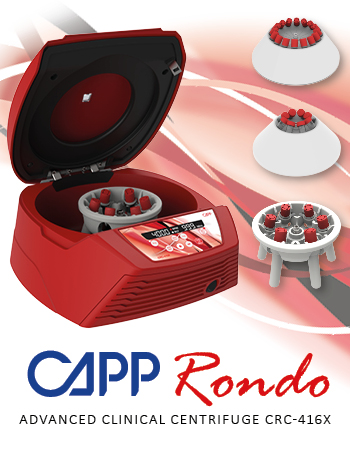
Blood separation with a swing-out rotor
Blood separation centrifuges with a swing-out rotor will allow particles to deposit evenly at the bottom of the tube. One advantage of using this blood separation approach is the ease of separation of blood components after centrifugation. Another advantage of this blood separation technique lies in the use of smaller centrifugal forces, which reduces energy consumption. Swing-out rotors are commonly used for blood separation in medical and research laboratories. CAPP manufactures and supplies the CAPPRondo Advanced Clinical Centrifuge CRC-416X with an optional swing-out rotor (6x10mL tubes) for blood separation. This premium blood separation machine can deliver centrifugal forces of up to 2,270g at variable speeds up to 4,000 RPM.
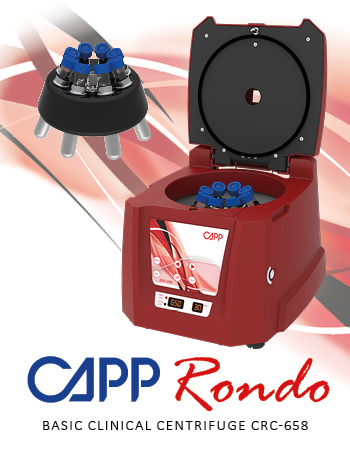
Blood separation with a fixed-angle rotor
Recommended centrifuge speed for blood
Blood separation by centrifugation is a fast process that is usually completed in less than 15 minutes. Before blood separation is started, it is important to collect the blood sample in the correct tube for blood separation work. After this is done, let the sample sit on the bench for thirty minutes to an hour for the blood to coagulate in the collection tube. For best results, it would not be advisable to let the collection tube sit unrefrigerated for longer than an hour before centrifuging the blood. For clinical applications, blood separation centrifuges with lower centrifugal force, such as the CAPPRondo Advanced Clinical Centrifuge CRC-416X, are preferred. Research applications requiring quick turnover may use the CAPPRondo Basic Clinical Centrifuge with a higher centrifugal force for shorter blood separation times.
White blood cells are separated from red blood cells before analysis to make it easier for researchers and clinicians to analyze them. There are much fewer white blood cells in whole blood compared to red blood cells. As a result, it would be difficult for scientists to access the white blood cells for routine clinical assays and research without an initial blood separation step. The blood separation techniques that are used usually create a distinct layer of white blood cells that scientists can then remove for further analysis. When scientists use blood separation centrifuges to separate white blood cells from red blood cells, the white blood cells are located in a layer known as the Buffy coat.
Centrifuged blood
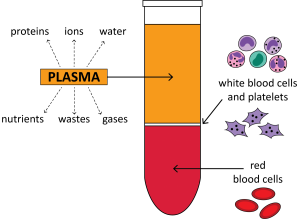 Centrifuged blood has a multi-layered appearance with three horizontal stacks of different colors. When you remove a specimen tube from the blood separation centrifuge, the three colored layers are easy to tell apart. The straw colored top layer consists of plasma, the liquid portion of blood, and it accounts for 55% of the total blood volume. The layer below the plasma may have a whitish or gray coloration. White blood cells and platelets occupy this layer of centrifuged blood and it is referred to as the Buffy coat. The lowest layer contains red blood cells and these account for 45% of the total blood volume. The color of the lowest layer of centrifuged blood may appear dark red or bright red depending on the oxygen content of the cells. It is quick and easy to get excellent separation of centrifuged blood with the aid of a high-quality blood separation centrifuge such as the CAPPRondo Advanced Clinical Centrifuge CRC-416X.
Centrifuged blood has a multi-layered appearance with three horizontal stacks of different colors. When you remove a specimen tube from the blood separation centrifuge, the three colored layers are easy to tell apart. The straw colored top layer consists of plasma, the liquid portion of blood, and it accounts for 55% of the total blood volume. The layer below the plasma may have a whitish or gray coloration. White blood cells and platelets occupy this layer of centrifuged blood and it is referred to as the Buffy coat. The lowest layer contains red blood cells and these account for 45% of the total blood volume. The color of the lowest layer of centrifuged blood may appear dark red or bright red depending on the oxygen content of the cells. It is quick and easy to get excellent separation of centrifuged blood with the aid of a high-quality blood separation centrifuge such as the CAPPRondo Advanced Clinical Centrifuge CRC-416X.
Click here to learn more about the unique features of this premium blood separation centrifuge.
Blood separation centrifuges work by spinning blood samples (in collection tubes) at high speeds. The high rotation speeds exert a rotational force on the blood collection tubes that is referred to as the centrifugal force. When blood collection tubes are spun in a blood separation centrifuge, the centrifugal force separates the various components of blood as a function of their density and quantity in the sample. Thus, the various components of blood can be separated into different layers for easy separation by simply running the blood samples in a high-quality blood separation centrifuge such as the CAPPRondo Basic Clinical Centrifuge.
Plasmapheresis is a procedure that is used in clinical facilities to separate plasma (the liquid portion of whole blood) from blood cells. Although most blood separation techniques such as centrifugation are conducted in a laboratory environment, plasmapheresis can be conducted in a clinical facility. Blood separation by plasmapheresis may be used to exchange unhealthy plasma in patients for healthy plasma from a donor. The process of plasmapheresis usually involves a two-way blood separation process. As plasma leaves the body the individual receives saline to protect them from dehydration.
Looking for a blood separation centrifuge?
 If you are looking for a blood separation centrifuge with excellent value and dependable accuracy, CAPP supplies some of the best blood separation machines on the market. The CAPPRondo line of blood separation centrifuges includes both fixed-angle and swing-out rotor options. These include the CAPPRondo Advanced Clinical Centrifuge CRC-416X and the CAPPRondo Basic Clinical Centrifuge CRC-658. Both blood separation machines offer innovative features that are designed to help you get the most out of each blood separation.
If you are looking for a blood separation centrifuge with excellent value and dependable accuracy, CAPP supplies some of the best blood separation machines on the market. The CAPPRondo line of blood separation centrifuges includes both fixed-angle and swing-out rotor options. These include the CAPPRondo Advanced Clinical Centrifuge CRC-416X and the CAPPRondo Basic Clinical Centrifuge CRC-658. Both blood separation machines offer innovative features that are designed to help you get the most out of each blood separation.
Click here to test out the CAPPRondo Advanced Clinical Centrifuge CRC-416X for free worldwide. To try out the CAPPRondo Basic Clinical Centrifuge CRC-658 click here. CAPPRondo blood separation centrifuges are your only “truly accurate, truly robust” partners for blood separation work!

